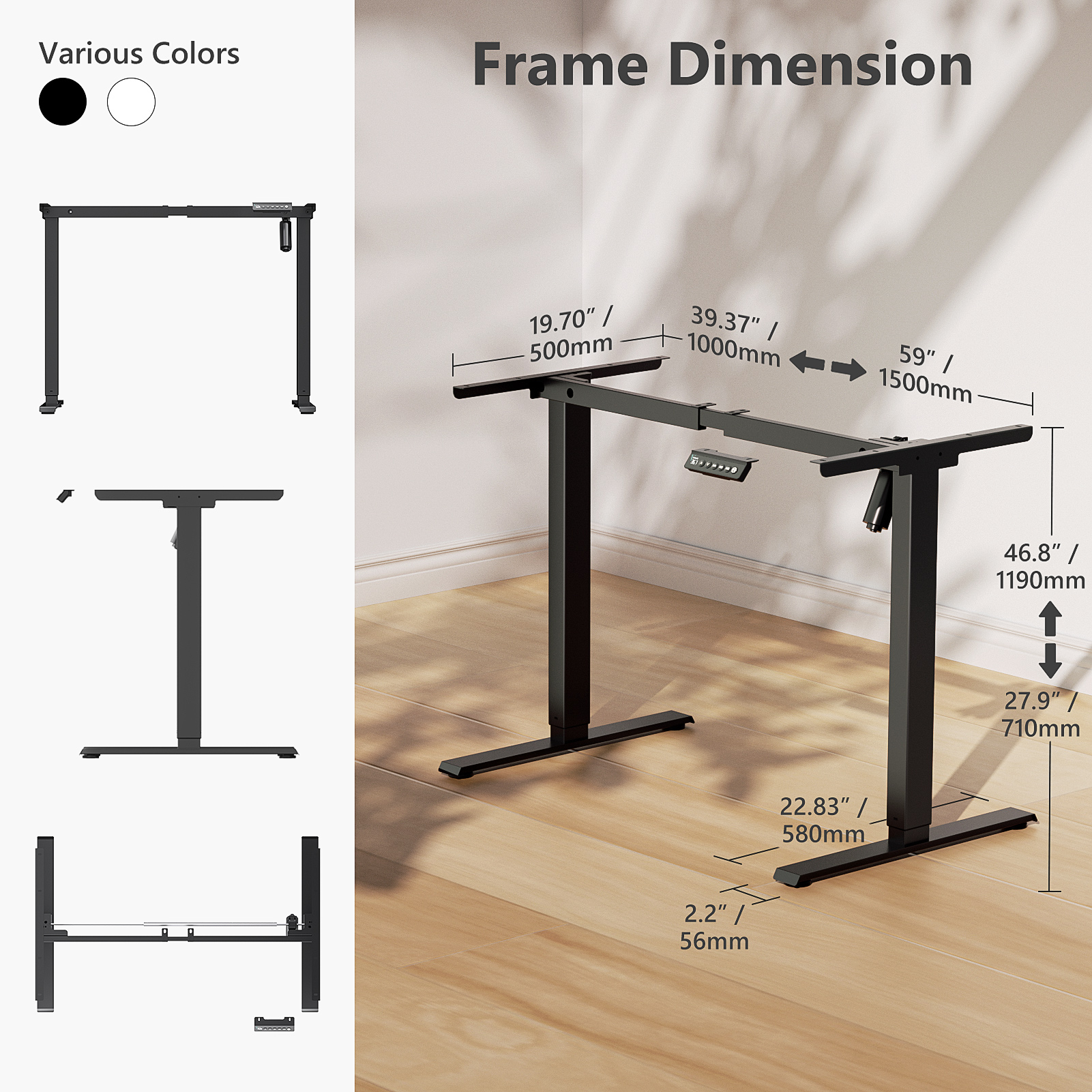Height-adjustable desks have become an essential tool for improving productivity, health, and overall well-being in modern workspaces. By allowing you to alternate between sitting and standing, a sit-stand desk can help reduce the negative effects of prolonged sitting. However, simply owning a height-adjustable standing desk is not enough; setting it up properly is crucial to achieving the best ergonomic benefits and comfort. Here are some tips on how to create the perfect setup to ensure you get the most out of your height-adjustable desk.
1. Set the Right Desk Height
One of the most critical aspects of your height-adjustable desk setup is the desk height. If the desk is too high or too low, it can lead to discomfort and poor posture, which can strain your back, neck, and wrists. When adjusting the desk, make sure your standing height allows your elbows to form a 90-degree angle. Ideally, your forearms should be parallel to the floor, and your hands should rest comfortably on the keyboard.
For shorter people, a desk with a broad range of adjustable heights will be beneficial, allowing for proper alignment. Taller people will need a desk that accommodates their height adjustment range for a more comfortable setup. Many height-adjustable desks come with electric adjustments that allow for quick and precise changes, while others may be manual desks or feature a lower range frame, requiring extra attention during setup. Proper desk height can reduce strain on your legs and lower back, improving your overall posture.
If you’re using a standard desk without adjustable height features, a desk converter might be the best solution. It allows you to raise your desk to a standing position, giving you the flexibility to alternate between sitting and standing throughout the day. Some desks, like the Uplift V2, are designed to easily switch between sitting and standing with preset desk heights for quick adjustments. For users who prefer specific heights, models like the Uplift V2-Commercial desk offer multiple preset options, making transitions between sitting and standing easier.
2. Use an Adjustable Chair for Sitting Breaks
While standing provides numerous health benefits, it’s important to balance standing with sitting breaks. A height-adjustable desk should allow you to switch easily between sitting and standing. For sitting, use an adjustable chair that supports your back and promotes proper posture. Your feet should be flat on the floor, and your knees should be at a 90-degree angle.
An ergonomic chair with adjustable height can help maintain proper alignment, and it’s important to pair it with an ergonomic desk setup to reduce strain while seated. If you frequently alternate between sitting and standing, a customizable desk and chair will make these transitions seamless. If you’re using an L-shaped standing desk or a corner desk, ensure both your chair and desk are properly adjusted to fit your body’s measurements.
3. Position Your Monitor Correctly
Monitor placement is just as important as desk height when using a height-adjustable desk. Incorrect positioning can lead to neck and back pain. Your monitor should be positioned so that the top of the screen is at or just below eye level when standing. This helps prevent neck strain, especially if you spend long hours working at your desk.
For taller people, a monitor arm with an adjustable height range is a great solution to ensure the screen is at the right height. Shorter individuals can benefit from using a desk converter or adjustable desk riser. Additionally, consider using keyboard trays and mouse extensions to maintain a natural arm position while typing. Many standing desks offer integrated technology that provides enhanced control over monitor positioning to meet your specific ergonomic needs.
If you prefer an executive desk or specialty desk, these often offer more space for larger monitors or additional equipment, combining functionality and aesthetics for a well-rounded workspace.
4. Choose Supportive Footwear and Add an Anti-Fatigue Mat
Your choice of footwear plays a significant role in your comfort when standing at a height-adjustable desk. Standing for long periods can cause fatigue, especially on hard floors. Wear supportive shoes with cushioning to help reduce pressure on your feet and legs. Avoid flat shoes or high heels, as they can increase strain.
An anti-fatigue mat is another useful addition to your desk setup. These mats reduce foot and leg fatigue, allowing you to stand for longer periods without discomfort. Whether you’re using an electric standing desk or a manual one, a desk mat provides extra cushioning and support, improving comfort throughout your workday. Anti-fatigue mats also help maintain proper blood circulation during extended periods of standing.
For those seeking an aesthetically pleasing desk setup, solid wood furniture or laminate options like Walnut Laminate or Eco Curve desktops can offer both durability and visual appeal.
5. Ensure a Clutter-Free Workspace
A clean, organized desk helps you stay focused and reduces distractions. When setting up your height-adjustable desk, make sure to keep your workspace tidy. Use cable trays or built-in cable management to keep wires organized and prevent clutter. An organized desk not only improves your workflow but also contributes to a more comfortable environment.
Many desks come with customizable features like built-in cable management solutions and control paddles for adjusting the desk height. These features make a big difference in reducing clutter and ensuring an ergonomic, functional workspace. USB ports built into some desks are also convenient for charging devices, further enhancing workspace efficiency.
If you’re looking for additional storage, choose a desk with built-in drawers to keep your work essentials organized.
6. Alternate Between Sitting and Standing
One of the main benefits of using a height-adjustable desk is the ability to alternate between sitting and standing. This movement helps reduce the strain caused by prolonged sitting. While standing for long periods improves circulation, it’s also important not to remain stationary for too long.
Try standing for 30 minutes to an hour at a time, then sit for a break. This alternation will help you stay comfortable and maintain your energy levels throughout the day. Many modern desks come with dual motors, which provide smoother, quieter transitions between sitting and standing, and memory presets allow you to return quickly to your preferred height.
If you need more space or work in an environment that requires a larger, more robust setup, desks like the V2-Commercial desk offer ample room for equipment. These desks also have preset heights, anti-collision features, and support multiple users, making them ideal for shared workspaces.
7. Customize Your Desk to Fit Your Needs
The beauty of a height-adjustable desk lies in its customization. Choose a desktop material that matches your style and needs, such as solid wood, bamboo, or laminate. If you have a larger workspace, consider an L-shaped or adjustable corner desk to provide more room for work essentials.
For smaller spaces, a compact desk may be more suitable. Regardless of the size or type, ensure your desk has the features that will support your daily activities. Many desks offer customizable features like adjustable heights and ranges, allowing you to modify the setup to your ideal configuration.
If you’re looking for an easy assembly process, ensure the desk comes with clear, easy-to-follow instructions. Desks that require minimal assembly are ideal for busy professionals.
8. Prioritize Durability and Stability
When choosing a height-adjustable desk, consider the weight capacity and durability of the frame. A sturdy metal frame or 3-stage legs will provide support, especially for heavier equipment like monitors or desktop computers. Desks made from materials like solid wood or Walnut Laminate are known for their durability and long-lasting performance.
If you’re using a motorized desk, check that the desk has a high lifting capacity and includes electric controls for efficient adjustments. Many high-quality desks also come with a 5-year warranty, ensuring their longevity. For extra stability, many desks offer low-range frames or 2-tier bases that improve sturdiness.
Some modern desks also feature anti-collision technology, which prevents damage to the desk or surrounding furniture if an obstruction is encountered while adjusting. This is especially valuable in dynamic workspaces where items are frequently moved around.
9. Optimize for Cable Management
Effective cable management is essential when setting up a standing desk. Use built-in cable management features or add cable trays to keep your workspace tidy. Proper cable management reduces clutter, enhances safety, and improves the overall aesthetic of your desk.
Many modern desks include cable management solutions such as built-in hooks or channels to help keep cords out of sight while maintaining easy access. These features prevent cables from tangling, which is crucial in dynamic work environments where desks frequently transition between sitting and standing.
Conclusion
A height-adjustable desk can provide numerous health benefits, improve productivity, and create a more comfortable workspace. By customizing your desk to suit your body, ensuring proper monitor and chair placement, and integrating features like adjustable height ranges and anti-fatigue mats, you can create a workspace that promotes better posture and reduces discomfort. Whether you opt for an electric standing desk, a manual desk, or a corner desk, the right setup will help you feel more comfortable, productive, and healthier throughout your workday.

